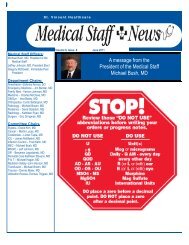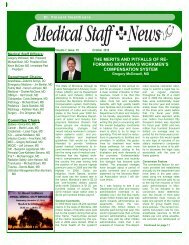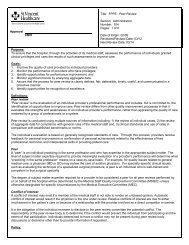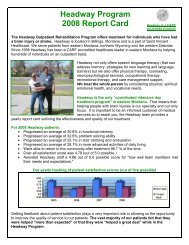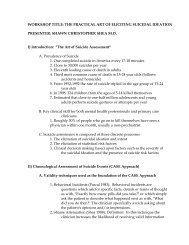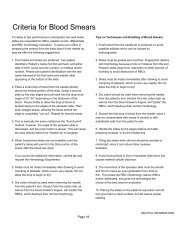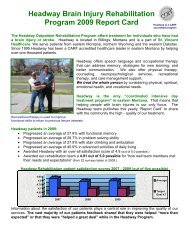AHA/ASA Guideline Guidelines for the Prevention of Stroke in ...
AHA/ASA Guideline Guidelines for the Prevention of Stroke in ...
AHA/ASA Guideline Guidelines for the Prevention of Stroke in ...
You also want an ePaper? Increase the reach of your titles
YUMPU automatically turns print PDFs into web optimized ePapers that Google loves.
274 <strong>Stroke</strong> January 2011456. Castro LH, Monteiro ML, Barbosa ER, Scaff M, Canelas HM. Fabry’sdisease <strong>in</strong> a female carrier with bilateral thalamic <strong>in</strong>farcts: a case reportand a family study. Sao Paulo Med J. 1994;112:649–653.457. Frustaci A, Chimenti C, Ricci R, Natale L, Russo MA, Pieroni M, EngCM, Desnick RJ. Improvement <strong>in</strong> cardiac function <strong>in</strong> <strong>the</strong> cardiac variant<strong>of</strong> Fabry’s disease with galactose-<strong>in</strong>fusion <strong>the</strong>rapy. N Engl J Med.2001;345:25–32.458. Rolfs A, Bottcher T, Zschiesche M, Morris P, W<strong>in</strong>chester B, Bauer P,Walter U, Mix E, Lohr M, Harzer K, Strauss U, Pahnke J, GrossmannA, Benecke R. Prevalence <strong>of</strong> Fabry disease <strong>in</strong> patients with cryptogenicstroke: a prospective study. Lancet. 2005;366:1794–1796.459. Eng CM, Guffon N, Wilcox WR, Germa<strong>in</strong> DP, Lee P, Waldek S, CaplanL, L<strong>in</strong>thorst GE, Desnick RJ; International Collaborative Fabry DiseaseStudy Group. Safety and efficacy <strong>of</strong> recomb<strong>in</strong>ant human alphagalactosidaseA–replacement <strong>the</strong>rapy <strong>in</strong> Fabry’s disease. N Engl J Med.2001;345:9–16.460. Banikazemi M, Bultas J, Waldek S, Wilcox WR, Whitley CB,McDonald M, F<strong>in</strong>kel R, Packman S, Bichet DG, Warnock DG, DesnickRJ. Agalsidase-beta <strong>the</strong>rapy <strong>for</strong> advanced Fabry disease: a randomizedtrial. Ann Intern Med. 2007;146:77–86.461. Germa<strong>in</strong> DP, Waldek S, Banikazemi M, Bush<strong>in</strong>sky DA, Charrow J,Desnick RJ, Lee P, Loew T, Vedder AC, Abichandani R, Wilcox WR,Guffon N. Susta<strong>in</strong>ed, long-term renal stabilization after 54 months <strong>of</strong>agalsidase beta <strong>the</strong>rapy <strong>in</strong> patients with Fabry disease. J Am SocNephrol. 2007;18:1547–1557.462. Bierer G, Balfe D, Wilcox WR, Mosenifar Z. Improvement <strong>in</strong> serialcardiopulmonary exercise test<strong>in</strong>g follow<strong>in</strong>g enzyme replacement<strong>the</strong>rapy <strong>in</strong> Fabry disease. J Inherit Metab Dis. 2006;29:572–579.463. Beer M, Weidemann F, Breunig F, Knoll A, Koeppe S, Machann W,Hahn D, Wanner C, Strotmann J, Sandstede J. Impact <strong>of</strong> enzymereplacement <strong>the</strong>rapy on cardiac morphology and function and lateenhancement <strong>in</strong> Fabry’s cardiomyopathy. Am J Cardiol. 2006;97:1515–1518.464. Moore DF, Scott LT, Gladw<strong>in</strong> MT, Altarescu G, Kaneski C, SuzukiK, Pease-Fye M, Ferri R, Brady RO, Herscovitch P, Schiffmann R.Regional cerebral hyperperfusion and nitric oxide pathway dysregulation<strong>in</strong> Fabry disease: reversal by enzyme replacement <strong>the</strong>rapy.Circulation. 2001;104:1506–1512.465. Wilcox WR, Banikazemi M, Guffon N, Waldek S, Lee P, L<strong>in</strong>thorst GE,Desnick RJ, Germa<strong>in</strong> DP. Long-term safety and efficacy <strong>of</strong> enzymereplacement <strong>the</strong>rapy <strong>for</strong> Fabry disease. Am J Hum Genet. 2004;75:65–74.466. Germa<strong>in</strong> DP. Fabry disease: <strong>the</strong> need to stratify patient populations tobetter understand <strong>the</strong> outcome <strong>of</strong> enzyme replacement <strong>the</strong>rapy. Cl<strong>in</strong>Ther. 2007;29(suppl A):S17–S18.467. Eng CM, Germa<strong>in</strong> DP, Banikazemi M, Warnock DG, Wanner C,Hopk<strong>in</strong> RJ, Bultas J, Lee P, Sims K, Brodie SE, Pastores GM, StrotmannJM, Wilcox WR. Fabry disease: guidel<strong>in</strong>es <strong>for</strong> <strong>the</strong> evaluation and management<strong>of</strong> multi-organ system <strong>in</strong>volvement. Genet Med. 2006;8:539–548.468. Davie CA, O’Brien P. <strong>Stroke</strong> and pregnancy. J Neurol NeurosurgPsychiatry. 2008;79:240–245.469. James AH, Bushnell CD, Jamison MG, Myers ER. Incidence and riskfactors <strong>for</strong> stroke <strong>in</strong> pregnancy and <strong>the</strong> puerperium. Obstet Gynecol.2005;106:509–516.470. Salonen Ros H, Lichtenste<strong>in</strong> P, Bellocco R, Petersson G, Cnatt<strong>in</strong>gius S.Increased risks <strong>of</strong> circulatory diseases <strong>in</strong> late pregnancy and puerperium.Epidemiology. 2001;12:456–460.471. Bates SM, Greer IA, Pab<strong>in</strong>ger I, S<strong>of</strong>aer S, Hirsh J. Venous thromboembolism,thrombophilia, antithrombotic <strong>the</strong>rapy, and pregnancy:American College <strong>of</strong> Chest Physicians Evidence-Based Cl<strong>in</strong>ical Practice<strong>Guidel<strong>in</strong>e</strong>s (8th edition). Chest. 2008;133(suppl 6):844S–886S.472. Lebaudy C, Hulot JS, Amoura Z, Costedoat-Chalumeau N, Serreau R,Ankri A, Conard J, Cornet A, Dommergues M, Piette JC, Lechat P.Changes <strong>in</strong> enoxapar<strong>in</strong> pharmacok<strong>in</strong>etics dur<strong>in</strong>g pregnancy and implications<strong>for</strong> antithrombotic <strong>the</strong>rapeutic strategy. Cl<strong>in</strong> Pharmacol Ther.2008;84:370–377.473. T<strong>in</strong>cani A, Branch W, Levy RA, Piette JC, Carp H, Rai RS, KhamashtaM, Shoenfeld Y. Treatment <strong>of</strong> pregnant patients with antiphospholipidsyndrome. Lupus. 2003;12:524–529.474. Coomarasamy A, Honest H, Papaioannou S, Gee H, Khan KS. Aspir<strong>in</strong><strong>for</strong> prevention <strong>of</strong> preeclampsia <strong>in</strong> women with historical risk factors: asystematic review. Obstet Gynecol. 2003;101:1319–1332.475. CLASP (Collaborative Low-dose Aspir<strong>in</strong> Study <strong>in</strong> Pregnancy) CollaborativeGroup. CLASP: a randomised trial <strong>of</strong> low-dose aspir<strong>in</strong> <strong>for</strong> <strong>the</strong>prevention and treatment <strong>of</strong> pre-eclampsia among 9364 pregnantwomen. Lancet. 1994;343:619–629.476. Kozer E, Nikfar S, Costei A, Boskovic R, Nulman I, Koren G. Aspir<strong>in</strong>consumption dur<strong>in</strong>g <strong>the</strong> first trimester <strong>of</strong> pregnancy and congenitalanomalies: a meta-analysis. Am J Obstet Gynecol. 2002;187:1623–1630.477. Viscoli CM, Brass LM, Kernan WN, Sarrel PM, Suissa S, Horwitz RI.A cl<strong>in</strong>ical trial <strong>of</strong> estrogen-replacement <strong>the</strong>rapy after ischemic stroke.N Engl J Med. 2001;345:1243–1249.478. Grady D, Herr<strong>in</strong>gton D, Bittner V, Blumenthal R, Davidson M, HlatkyM, Hsia J, Hulley S, Herd A, Khan S, Newby LK, Waters D, Vitt<strong>in</strong>gh<strong>of</strong>fE, Wenger N; <strong>for</strong> <strong>the</strong> HERS Research Group. Cardiovascular diseaseoutcomes dur<strong>in</strong>g 6.8 years <strong>of</strong> hormone <strong>the</strong>rapy: Heart and Estrogen/Progest<strong>in</strong> Replacement Study follow-up (HERS II). JAMA. 2002;288:49–57.479. Wasser<strong>the</strong>il-Smoller S, Hendrix SL, Limacher M, Heiss G, KooperbergC, Baird A, Kotchen T, Curb JD, Black H, Rossouw JE, Aragaki A,Saf<strong>for</strong>d M, Ste<strong>in</strong> E, Laowattana S, Mysiw WJ. Effect <strong>of</strong> estrogen plusprogest<strong>in</strong> on stroke <strong>in</strong> postmenopausal women: <strong>the</strong> Women’s HealthInitiative. A randomized trial. JAMA. 2003;289:2673–2684.480. Hendrix SL, Wasser<strong>the</strong>il-Smoller S, Johnson KC, Howard BV,Kooperberg C, Rossouw JE, Trevisan M, Aragaki A, Baird AE, BrayPF, Bur<strong>in</strong>g JE, Criqui MH, Herr<strong>in</strong>gton D, Lynch JK, Rapp SR, TornerJ. Effects <strong>of</strong> conjugated equ<strong>in</strong>e estrogen on stroke <strong>in</strong> <strong>the</strong> Women’sHealth Initiative. Circulation. 2006;113:2425–2434.481. Utian WH, Archer DF, Bachmann GA, Gallagher C, Grodste<strong>in</strong> F,Heiman JR, Henderson VW, Hodis HN, Karas RH, Lobo RA, MansonJE, Reid RL, Schmidt PJ, Stuenkel CA. Estrogen and progestogen use <strong>in</strong>postmenopausal women: July 2008 position statement <strong>of</strong> <strong>the</strong> NorthAmerican Menopause Society. Menopause. 2008;15:584–602.482. Grodste<strong>in</strong> F, Manson J, Stampfer M, Rexrode K. Postmenopausalhormone <strong>the</strong>rapy and stroke: role <strong>of</strong> time s<strong>in</strong>ce menopause and age at<strong>in</strong>itiation <strong>of</strong> hormone <strong>the</strong>rapy. Arch Intern Med. 2008;168:861–866.483. Rossouw JE, Prentice RL, Manson JE, Wu L, Barad D, Barnabei VM,Ko M, LaCroix AZ, Margolis KL, Stefanick ML. Postmenopausalhormone <strong>the</strong>rapy and risk <strong>of</strong> cardiovascular disease by age and yearss<strong>in</strong>ce menopause. JAMA. 2007;297:1465–1477.484. Bertram M, Bonsanto M, Hacke W, Schwab S. Manag<strong>in</strong>g <strong>the</strong> <strong>the</strong>rapeuticdilemma: patients with spontaneous <strong>in</strong>tracerebral hemorrhage andurgent need <strong>for</strong> anticoagulation. J Neurol. 2000;247:209–214.485. Butler AC, Tait RC. Restart<strong>in</strong>g anticoagulation <strong>in</strong> pros<strong>the</strong>tic heart valvepatients after <strong>in</strong>tracranial haemorrhage: a 2-year follow-up. Br JHaematol. 1998;103:1064–1066.486. Broderick JP, Brott TG, Tomsick T, Barsan W, Spilker J. Ultra-earlyevaluation <strong>of</strong> <strong>in</strong>tracerebral hemorrhage. J Neurosurg. 1990;72:195–199.487. Flibotte JJ, Hagan N, O’Donnell J, Greenberg SM, Rosand J. Warfar<strong>in</strong>,hematoma expansion, and outcome <strong>of</strong> <strong>in</strong>tracerebral hemorrhage. Neurology.2004;63:1059–1064.488. Broderick JP, Adams HP Jr, Barsan W, Fe<strong>in</strong>berg W, Feldmann E, GrottaJ, Kase C, Krieger D, Mayberg M, Tilley B, Zabramski JM, ZuccarelloM. <strong>Guidel<strong>in</strong>e</strong>s <strong>for</strong> <strong>the</strong> management <strong>of</strong> spontaneous <strong>in</strong>tracerebral hemorrhage:a statement <strong>for</strong> healthcare pr<strong>of</strong>essionals from a special writ<strong>in</strong>ggroup <strong>of</strong> <strong>the</strong> <strong>Stroke</strong> Council, American Heart Association. <strong>Stroke</strong>. 1999;30:905–915.489. Flaherty ML, Tao H, Haverbusch M, Sekar P, Kle<strong>in</strong>dorfer D, Kissela B,Khatri P, Stettler B, Adeoye O, Moomaw CJ, Broderick JP, Woo D.Warfar<strong>in</strong> use leads to larger <strong>in</strong>tracerebral hematomas. Neurology. 2008;71:1084–1089.490. Aguilar MI, Hart RG, Kase CS, Freeman WD, Hoeben BJ, Garcia RC,Ansell JE, Mayer SA, Norrv<strong>in</strong>g B, Rosand J, Ste<strong>in</strong>er T, Wijdicks EF,Yamaguchi T, Yasaka M. Treatment <strong>of</strong> warfar<strong>in</strong>-associated <strong>in</strong>tracerebralhemorrhage: literature review and expert op<strong>in</strong>ion. Mayo Cl<strong>in</strong> Proc.2007;82:82–92.491. Ste<strong>in</strong>er T, Rosand J, Dir<strong>in</strong>ger M. Intracerebral hemorrhage associatedwith oral anticoagulant <strong>the</strong>rapy: current practices and unresolvedquestions. <strong>Stroke</strong>. 2006;37:256–262.492. Leiss<strong>in</strong>ger CA, Blatt PM, Hoots WK, Ewenste<strong>in</strong> B. Role <strong>of</strong> prothromb<strong>in</strong>complex concentrates <strong>in</strong> revers<strong>in</strong>g warfar<strong>in</strong> anticoagulation: a review <strong>of</strong><strong>the</strong> literature. Am J Hematol. 2008;83:137–143.493. Phan TG, Koh M, Wijdicks EF. Safety <strong>of</strong> discont<strong>in</strong>uation <strong>of</strong> anticoagulation<strong>in</strong> patients with <strong>in</strong>tracranial hemorrhage at high thromboembolicrisk. Arch Neurol. 2000;57:1710–1713.494. Ananthasubramaniam K, Beattie JN, Rosman HS, Jayam V, Borzak S.How safely and <strong>for</strong> how long can warfar<strong>in</strong> <strong>the</strong>rapy be withheld <strong>in</strong>pros<strong>the</strong>tic heart valve patients hospitalized with a major hemorrhage?Chest. 2001;119:478–484.Downloaded from stroke.ahajournals.org by on March 8, 2011



